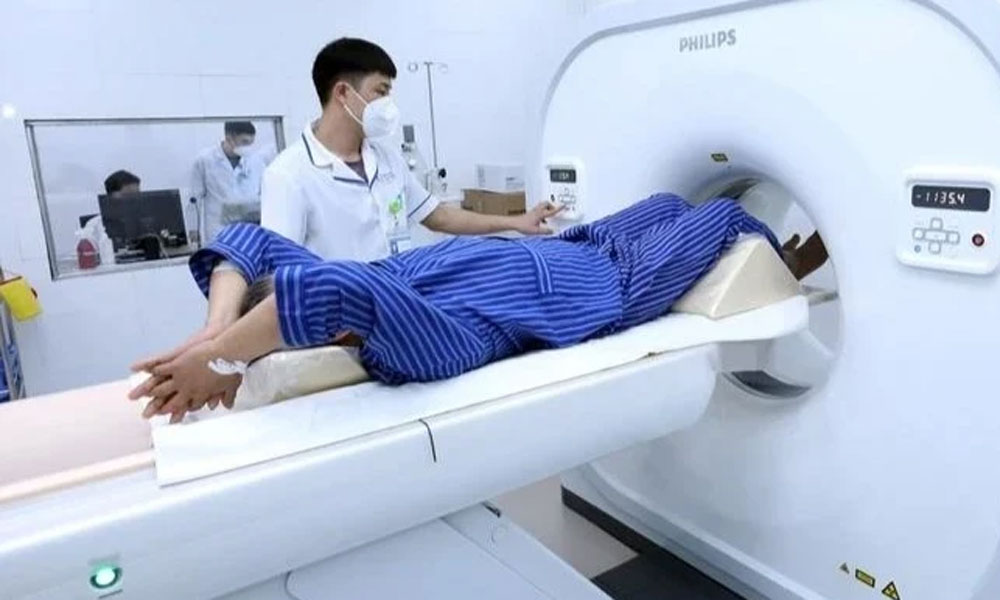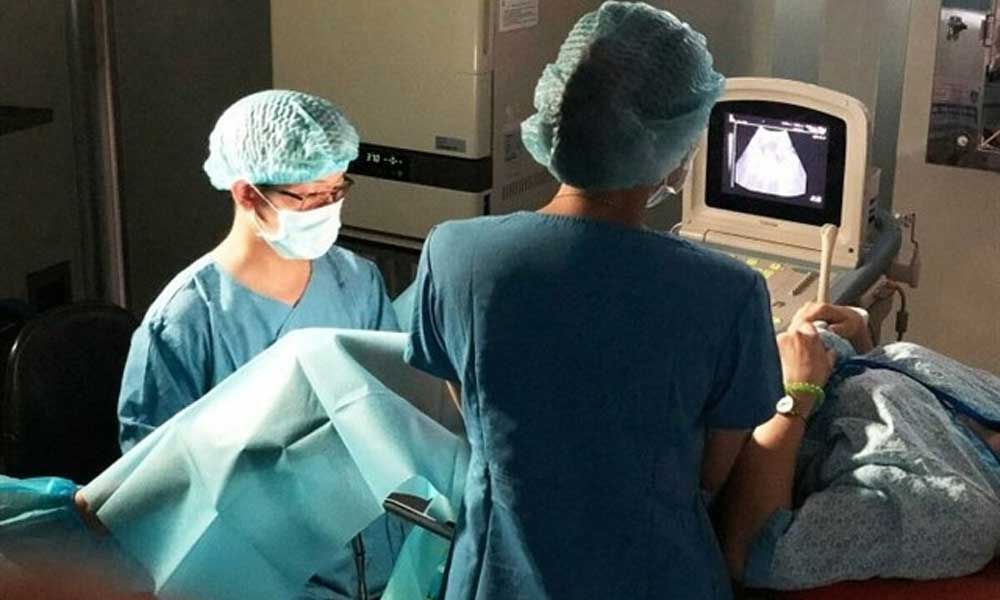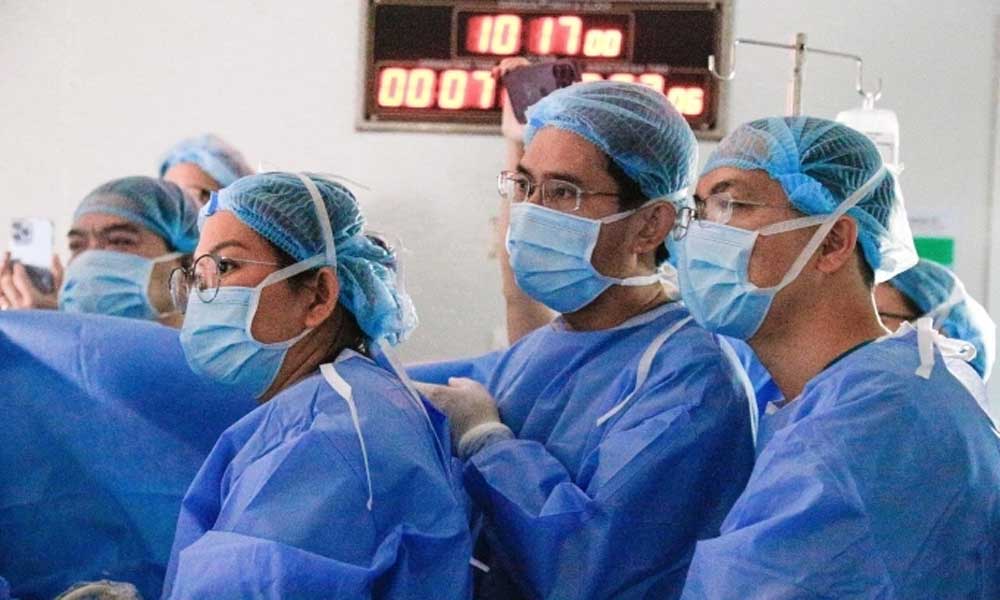Viet Nam improves the quality of diagnosis and treatment
In medical facilities, the application of modern technology has improved the quality of medical examination and treatment, helping to optimise resources, save time and reduce the burden on patients. Modern technology opens opportunities for effective treatment of complex diseases that were previously difficult or had no intervention methods.
Viet Nam’s health sector has made significant progress in applying digital technology, such as: deploying electronic medical records; integrating big data; applying artificial intelligence (AI) in diagnostic imaging, etc., thus helping to improve the efficiency, speed, and quality of healthcare services.
 |
|
Doctors perform CT scans to diagnose and treat patients. |
Master, Specialist II Doctor Nguyen Thi Hong Hoa, Deputy Director of Viet Nam-Sweden Uong Bi Hospital (Quang Ninh Province), said that as a general hospital with a grade I specialised technical level, the hospital examined and treated more than 357,000 patients in 2024.
Notably, the doctors here performed 14,500 techniques according to technical level. The application of high technology has brought about clear results in many areas, such as: in 2024, it became the first provincial hospital in the country to successfully perform multi-organ transplantation and kidney transplantation from living donors and brain-dead donors; conducting early cancer diagnosis thanks to advanced gene mutation screening and imaging techniques; utilising high-precision 3D endoscopy to reduce invasive interventions, intervention time, and errors; preserving function and shortening recovery time; and applying AI in reading CT and MRI images to improve accuracy and early warning of some dangerous diseases.
In addition, thanks to the implementation of Telemedicine (remote medical examination) connecting with experts at major medical centres in and outside the country, such as France, Belgium, Sweden, and Singapore, has helped patients access new treatment regimens and leading experts without having to transfer to higher levels; at the same time, training staff right at the hospital, effectively promoting medical human resources.
However, according to Dr Hoa, the biggest challenge currently when deploying high technology is the requirement of a large initial investment capital for equipment, along with costs for maintaining and operating the system to ensure patient safety.
Meanwhile, the current health insurance policy is still lagging behind in the practical implementation of technology. Many modern techniques have not yet been included in the health insurance payment list, and the co-payment rate of patients is still high, leading to the situation where many patients with high-tech indications delay or refuse treatment due to insufficient financial conditions, seriously affecting their health.
Sharing the above viewpoint, Associate Professor Dr Vu Van Giap, Deputy Director of Bach Mai Hospital (Ministry of Health), shared that Bach Mai is a special-class hospital which has applied many advanced technologies to improve the quality of medical examination, treatment, training, and scientific research, including AI, big data analysis, and stem cells.
However, there are still some challenges that need to be addressed, such as the effective construction and exploitation of big medical data.
Meanwhile, there are currently no specific payment instructions for electronic medical records, software-based treatment monitoring, AI-assisted diagnosis, etc.; and current service prices do not fully account for equipment investment costs, technology wear and tear, and specific consumables, and so on, leading to hospitals having to compensate for costs when deploying new techniques and technologies, thus limiting the ability to expand high-quality techniques in the public system.
Deputy Minister of Health Tran Van Thuan said that in recent time, the quality of diagnosis and treatment of diseases in our country has continued to improve, the hospital system has been constantly expanded, the capacity of grassroots healthcare has been strengthened, advanced technology has been widely transferred to the grassroots, and the rate of people participating in insurance has reached more than 94%, which has significantly reduced the cost burden for patients, especially among vulnerable groups.
In particular, digital transformation in health care has made many important strides, such as electronic health records and remote medical examination and treatment being initially implemented synchronously, helping to shorten access time, increase transparency and improve the effectiveness of diagnosis and treatment.
However, the rights of patients still have shortcomings; many medical facilities are overloaded, waiting times are long, and hidden costs still exist.
The lack of synchronisation of data connection leads to duplicate testing and diagnosis, causing costs and affecting the quality of treatment.
To further improve the quality of medical examination and treatment, especially the application of advanced technology in diagnosis and treatment at medical facilities nationwide, the health sector is currently orienting to amend the Law on Health Insurance to specify some contents, moving towards free medical examination and treatment for people.
It is expected that Viet Nam will amend the entire Law on Health Insurance in the near future, with many contents to be prioritised, especially the application of advanced techniques to screen and detect early some dangerous diseases.
Nguyen Thi Hong Hoa, Deputy Director of Viet Nam-Sweden Uong Bi Hospital, also suggested that the Ministry of Health should coordinate with relevant ministries and branches to soon supplement the list of advanced techniques covered by health insurance, based on scientific evidence and clinical data.
Attention should also be paid to develop policies to support the development of high technology in the early stages of application in public hospitals, especially for strategic techniques such as precision medicine, modern radiotherapy, surgical robots; increase payment levels or reduce co-payment rates for advanced techniques, especially for groups with severe, chronic, or rare diseases, and children.
 Bắc giang
Bắc giang













Reader's comments (0)